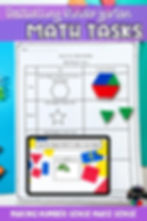5 Ideas For Low-Floor High-Ceiling Kindergarten: Building Thinking Classrooms Math Tasks
- Lara
- Jul 18
- 3 min read
Post contains affiliate links.
When starting the Building Thinking Classrooms framework, the most challenging part can be finding tasks that work for kindergarten. Let’s talk about some of my most loved, bestselling kindergarten math tasks.
Each task has an original task, and thin-sliced follow-up tasks designed to be completed within the same problem-solving session. Each thin slice is a little more challenging than the previous one, perfect for groups who tend to finish early. After students have completed the task, they have either 3 differentiated levels of a check your understanding follow-up tasks, or a game or activity to reinforce the learning, perfect for consolidation or a lesson wrap-up.
These tasks cover a range of topics like composing shapes, decomposing numbers to 10 in more than one way, sorting or classifying objects and counting the objects in each category, comparing objects by length, and composing and decomposing numbers 11-19 into a ten and some ones.

Composing Shapes Challenge
This task is set up in the form of challenges. (Most students love the idea of challenge as it helps “gamify” a task.) In the first challenge, you give your students the shape they are trying to build, like a trapezoid, at tell them to build that shape using three triangles. In the next task, you give them a shape like a rectangle, and tell them to make the rectangle with squares.
From there, instead of having them build another shape, give them something like a house or a rocket to keep them wanting to complete the challenges!
Sorting Math Task
This sorting task is called Toy Trouble! In it, your students have finished playing with a friend, and they need to count the toys they need to sort, then decide which one has more or fewer. As the thin-slicing and mild, medium, and spicy check your understanding continues, the number of items and the number of categories increase.
Decomposing Numbers Math Task
This task adds a bit of mystery to your decomposing number unit! Tell your students that you have five crayons hidden in your desk. Some are red and the rest are yellow. How many of each could there be? They can try to figure out each of the combinations of 5 as an extension, and give them larger numbers for the check-your-understanding piece. As a bonus, I suggest hiding the five crayons and having a reveal at the end of the lesson!
Teen Numbers Math Task
Similar to the previous task, this adds some curiosity to the task for higher engagement. For this task, you’ll need base ten blocks or cubes, and a bag that is not see-through. Tell your students that are are some cubes in a mystery bag! There is one ten rod (or tower of ten) and some ones or some loose cubes. They need to figure out how many cubes could be in the bag; the different combinations are the thin slices for this task.
For the reinforcement or check-your-understanding piece, they will have a base 10 rod and spin a number between 5 or 10 and add that many cubes to their ten rod. Afterwards, they can count to find the total number of cubes they have. This will help them work on the 10 + n structure and encourage them to count on from 10 instead of counting by 1.
Comparing Length Math Task
In this task, your students will have to figure out which objects are longer or shorter than their pencil! They are given a list of common classroom objects and compare them to the length of their pencil and record their findings. This task allows students to move around the room or stay at their boards, depending on how you set up the room, and is a fun switch-up from a lot of other tasks students might do.
This consolidation or check-your-understanding time is different from other tasks as it involves a game that can easily be made into a center! In it, your students spin a number and build a tower to match. After that, they compare the length of their tower to the object on the recording sheet, write the length of their tower in cubes, and decide if it is longer or shorter than the object on the sheet.
You can save on all of these tasks, or be set with tasks for each common core standard here!

